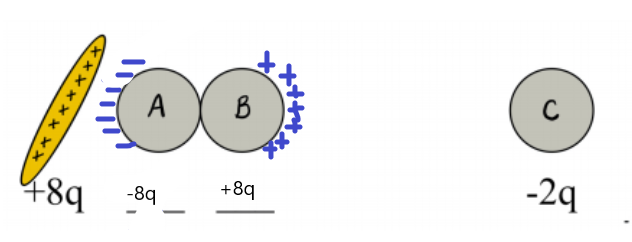Spheres A, B, and C are identical conductors. Spheres A and B are initially neutral. Sphere C initially has a charge of –2q. a) For each of the steps show, 1. Determine any unknown charge (represented as a 2. Draw the distribution of charges on each sphere. You may assume that any spheres that are not in contact are far enough away to not interact with each other. in the figure). 1. A positively charged rod is held close to, but not touching, two identical A B C spherical conductors. -29 2. Sphere B is moved away from Sphere A. A B C 48q -29 3. Sphere B is brought in A contact with Sphere C. 489 ***** ******e
Spheres A, B, and C are identical conductors. Spheres A and B are initially neutral. Sphere C initially has a charge of –2q. a) For each of the steps show, 1. Determine any unknown charge (represented as a 2. Draw the distribution of charges on each sphere. You may assume that any spheres that are not in contact are far enough away to not interact with each other. in the figure). 1. A positively charged rod is held close to, but not touching, two identical A B C spherical conductors. -29 2. Sphere B is moved away from Sphere A. A B C 48q -29 3. Sphere B is brought in A contact with Sphere C. 489 ***** ******e
Related questions
Question
100%

Transcribed Image Text:Spheres A, B, and C are identical conductors. Spheres A and B are initially neutral. Sphere C
initially has a charge of – 2q.
a) For each of the steps show,
1. Determine any unknown charge (represented as a
2. Draw the distribution of charges on each sphere. You may assume that any
spheres that are not in contact are far enough away to not interact with each other.
in the figure).
1. A positively
charged rod is
held close to, but
not touching, two
identical
A
B
C
spherical
489
-29
conductors.
2. Sphere B is
moved away
A
C
from Sphere A.
48q
-2q
3. Sphere B is
brought in
contact with
Sphere C.
A
B
489
4. The positively
charged rod is
removed and
A
B
C
Sphere B is
moved away
from Sphere C.
A
C
5. Sphere B is
removed.
|
Expert Solution
Step 1
When the positively charged rod is brought near the spheres A and B which are in contact, this rod will induce a charge on the surface of the sphere A which is closer to it.
Since the rod is positively charged with a charge +8q, an equal and opposite charge of -8q will be induced on the surface of the sphere A.
As this negative charge is induced on the surface of sphere A, this will in turn induce a positive charge on the surface of sphere B since they are in contact.
So, an equal and opposite amount of charge, +8q will be induced on surface of sphere B

Trending now
This is a popular solution!
Step by step
Solved in 4 steps with 3 images
